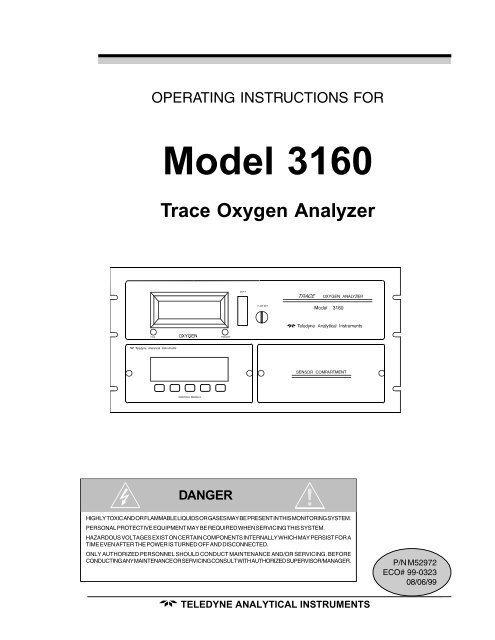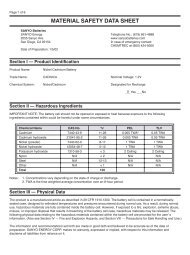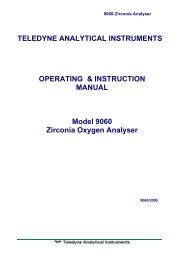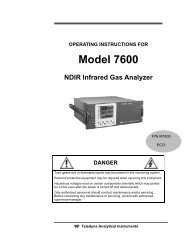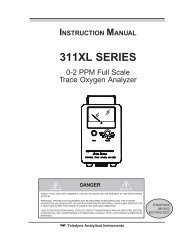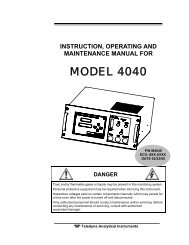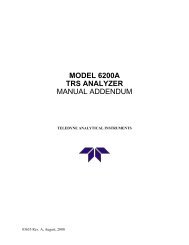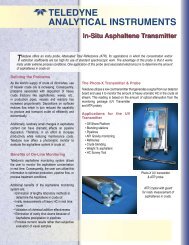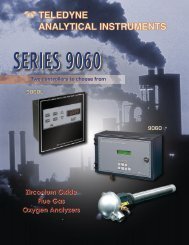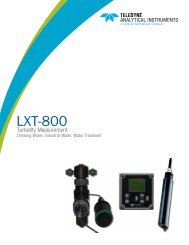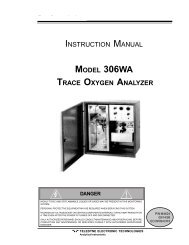3160 - Trace oxygen analyzer - Teledyne Analytical Instruments
3160 - Trace oxygen analyzer - Teledyne Analytical Instruments
3160 - Trace oxygen analyzer - Teledyne Analytical Instruments
- No tags were found...
You also want an ePaper? Increase the reach of your titles
YUMPU automatically turns print PDFs into web optimized ePapers that Google loves.
TELEDYNE ANALYTICAL INSTRUMENTSiii
Tabable of Contents1 Introduction1.1 Features ....................................................................................... 1-11.1.1 Fixed Features .............................................................. 1-11.1.2 Variable Features ......................................................... 1-11.2 Components ................................................................................. 1-31.3 Options and Model Numbers ........................................................ 1-31.4 Applications ................................................................................. 1-42 Operational Theory2.1 Principles of Operation ........................................................... 2-12.1.1 Micro-Fuel Cell Sensor ................................................. 2-32.1.2 Sample System .............................................................. 2-32.1.3 Electronics and Signal Processing ............................. 2-5Range Identifier Table ....................................................... 2-73 Installation4 Operations3.1 Unpacking the Analyzer ................................................................ 3-13.2 Front Panel ................................................................................. 3-13.3 Rear Panel ................................................................................... 3-23.4 Gas Line Connections ................................................................... 3-43.4.1 Span Gas In .................................................................. 3-43.4.2 Instrument Air ................................................................ 3-43.4.3 Sample Gas In ............................................................... 3-43.4.4 Vent .............................................................................. 3-43.5 Micro-Fuel Cell Installation or Replacement .................................. 3-53.6 Electrical Connections ............................................................. 3-63.6.1 Voltage Selection .......................................................... 3-73.6.2 Fuse Changing .............................................................. 3-83.6.3 Parallel and Serial Ports .......................................... 3-93.7 Installation Checklist ..................................................................... 3-104.1 Front Panel Controls ..................................................................... 4-14.1.1 Spinning Wheel ............................................................. 4-24.1.2 Cell Output Factor ........................................................ 4-24.2 Modes of Operation ..................................................................... 4-2Cold Start-Up ........................................................................ 4-5(continued)ivTELEDYNE ANALYTICAL INSTRUMENTS
Tabable of Contents (continued)Calibration Zeroing ........................................................... 4-6Calibration Using Span Gas .............................................. 4-8Select Active Sensor (Two Cells Only) ............................. 4-11Install Sensor and Test Alternate Sensor .... (Two Cells Only) .. 4-12O 2Range Set-Up .................................................................. 4-14Set-up Alarms ........................................................................ 4-15Logger Set-Up ....................................................................... 4-17Set-Up Clock Functions ......................................................... 4-19Changing Passwords For RemoteMonitoring and Control ......................................... 4-21System Statistics ..................................................................... 4-235 Maintenance & Troubleshooting5.1 Routine Maintenance .................................................................... 5-15.1.1 Sensor Maintenance ............................................... 5-15.1.2 Scrubber Maintenance .................................................. 5-15.2 Troubleshooting ............................................................................ 5-2AppendixA-1 Specifications Sheet ................................................................ A-1A-2 Recommended Spare Parts List .............................................. A-2A-3 Drawing List ........................................................................... A-3A-4 Material Safety Data Sheet ..................................................... A-4A-5 Material Safety Data Sheet ..................................................... A-5TELEDYNE ANALYTICAL INSTRUMENTSv
viTELEDYNE ANALYTICAL INSTRUMENTS
Introduction 1Introduction1.1 Features1.1.1 Fixed FeaturesThe Model <strong>3160</strong> is a microprocessor-based trace <strong>oxygen</strong> monitoring system thatprovides on-line monitoring of trace <strong>oxygen</strong> at parts-per-million (PPM) levels and candirectly measure the level of purity in high-grade gases.The <strong>3160</strong> computer uses an Intel ® 80188 microprocessor combined with 32kilobytes of random access memory (RAM) and 128 kilobytes of read-only memory(ROM). The total computer program resides in the ROM and is not affected by shutdownperiods, loss of power, or battery failure. However, calibration parameters andstored measurement readings are retained in battery-backed-up RAM, which requirecontinuous battery voltage in order to be retained. This information will be lost ifbattery power is interrupted, as in battery replacement.Two displays help you monitor trace <strong>oxygen</strong> levels: a red 4-digit light emittingdiode (LED) display with one-inch numerals is easily read at a distance or even inbright daylight, and a liquid crystal display (LCD) helps you keep track of alarmsetpoints, ranges, mode and system statistics.1.1.2 Variable FeaturesVarious models are available. The following features describe the basic model,but the exact configuration depends on the standard options incorporated. Paragraph1.3 contains a list of standard variations on the basic model.The Class B-2 Micro-Fuel Cell measures trace O 2in a mixture of gases. Becausethe Micro-Fuel Cell sensor is a sealed electrochemical device, it is replaced as a unit.There are no electrolytes to change or electrodes to clean, making the sensor maintenancefree. The <strong>analyzer</strong> can be configured with one or two sensor blocks. Each blockcan be isolated by pneumatically switched valves. The software automatically adjustswhen a second cell block is present.TELEDYNE ANALYTICAL INSTRUMENTS1-1
1 IntroductionThe <strong>3160</strong> features six full-scale linear ranges of analysis:• 0–1 PPM• 0–10 PPM• 0–100 PPM• 0–1000 PPM• 0–1%• 0–25%An AutoRanging feature automatically selects the range that is appropriate for agiven reading. For example, if the O 2level exceeds 100% of the current range, the<strong>analyzer</strong> switches to the next higher range. When desired, a manual override featureallows a particular range of interest to be locked-in.With the AutoSpan feature, the <strong>analyzer</strong> automatically calibrates at scheduledintervals, and automatically performs electronic zeroing and sensor settling detectionduring calibration.Five user-programmable absolute-reading (PPM) alarm setpoints with assignableForm 1C (SPDT) relays are provided, along with a RS-232C bidirectional serial dataport, and four signal outputs for chart recorders, etc. TheRS-232 serial port can be used with or without a modem to connect with• a personal computer loaded with the <strong>Teledyne</strong> Remote <strong>Analytical</strong>Control Software (TRACS)• any terminal or terminal emulation software• a custom computer programSeveral <strong>analyzer</strong> functions, including troubleshooting, can be run from your PCthrough the phone line to the <strong>analyzer</strong>.The <strong>analyzer</strong> has separate sample and span gas ports, which allow the installationof an external source of span gas for calibration without interfering with the samplegas line.An optional scrubber installed into the sample system allows sample gas to beused as a zero gas after treatment with the scrubber. If the scrubber is installed, pneumaticvalves on either side of the scrubber open automatically during zeroing.Note: Units equipped with a scrubber should only be used with inert gasesand saturated hydrocarbons.The <strong>analyzer</strong> output is not affected by minor changes in the flow rate. Analyzerperformance is stable under minor mechanical vibration.1-2TELEDYNE ANALYTICAL INSTRUMENTS
Introduction 11.2 ComponentsThe <strong>analyzer</strong> is designed to mount in a standard 19-inch rack. All of the operationalcontrols are easily accessed through the front panel. The <strong>analyzer</strong> contains eachof the following:• Analysis Section• Single or Dual Electrochemical Micro-Fuel Cell• Sample System• Power Supply• Microcontroller Module• LED DisplayThe front panel consists of:• LED Display• LCD Display with Touch Panel• Micro-Fuel Cell Access Panel• Flowmeter and flow set knobThe back panel ports are:• Gas Inlet/Outlet Ports• Electrical Connections1.3 Options and Model NumbersThe <strong>3160</strong> is available with the following standard options, which are designatedby a descriptive suffix on the model number. Most of the options can be combined.• <strong>3160</strong>SA Single fuel cell.• <strong>3160</strong>SB Single fuel cell and <strong>oxygen</strong> scrubber• <strong>3160</strong>DA Dual fuel cell• <strong>3160</strong>DB Dual fuel cell and <strong>oxygen</strong> scrubber• <strong>3160</strong>SAS Single cell and stainless steel cell block• <strong>3160</strong>SBS Single cell, stainless steel cell block, and <strong>oxygen</strong> scrubber• <strong>3160</strong>DAS Dual cell and stainless steel cell block• <strong>3160</strong>DBS Dual cell, stainless steel cell block, and <strong>oxygen</strong> scrubberTELEDYNE ANALYTICAL INSTRUMENTS1-3
1 Introduction1.4 ApplicationsThe <strong>analyzer</strong> is an invaluable tool in the following applications and industries:• Inert and gaseous hydrocarbon stream monitoring.• Measuring the purity of various gases in air separation plants.• Prevention of oxidation by measuring the purity of blanketing gases infiber and glass industries.• Monitoring and controlling gas atmospheres in the heat treatment of metalsin steel and other metal industries.• Gas analysis and research in laboratories and research and developmentareas.• Semiconductor manufacturing.• Process monitoring of gaseous monomers—vinyl chloride, propylene,butadiene, or ethylene.• Gas purity certification.• Glove box leak detection.• Natural gas treatment and transmission.• Inert gas welding of exotic metals.1-4TELEDYNE ANALYTICAL INSTRUMENTS
Operational Theory 2Operational Theory2.1 Principles of OperationThe sub-systems that make up the <strong>analyzer</strong> are:1. Micro-Fuel Cell Sensor2. Sample System3. Electronic Signal ProcessingThe Micro-Fuel Cell sensor is an electrochemical galvanic device that translatesthe amount of <strong>oxygen</strong> present in the sample into an electrical current. The samplesystem delivers the sample gas in a form that is as unaltered as possible for testing,and for leak-free transport of gases through the <strong>analyzer</strong>.The electronic signal processing unit (control module) is designed to simplify theoperation of the <strong>analyzer</strong> and accurately process the signal from various components.The control module incorporates a microprocessor which allows the operation of the<strong>analyzer</strong> with a minimum of operator interaction. Figure 2-1 illustrates majorcomponents.TELEDYNE ANALYTICAL INSTRUMENTS2-1
2 Operational TheoryIOFigure 2-1. Major Components.2-2TELEDYNE ANALYTICAL INSTRUMENTS
Operational Theory 22.1.1 Micro-Fuel Cell SensorThe Micro-Fuel Cell is a sealed plastic disposable <strong>oxygen</strong> transducer that measures1¼ inches in diameter and is ¾ inch thick. Inside of the cell are a cathode andanode immersed in 15% aqueous KOH electrolyte. At one end of the sensor is aTeflon diffusion membrane; the other end is sealed with a polyethylene membrane. Atthe rear of the cell is a contact plate consisting of two concentric foils. The foils matewith spring-loaded contacts in the sensor block assembly and provide the electricalconnection to the rest of the <strong>analyzer</strong>.The sensing cathode, located beneath the diffusion membrane, has a surface areaof 2.48 cm 2 . The sample gas enters the sensor block through an inlet tube between thecathode and the sensor block cap, diffuses through the Teflon membrane, and any<strong>oxygen</strong> in the sample gas is reduced on the surface of the cathode by the followingmechanism:O 2+ 2H 2O + 4e – → 4OH –(cathode)When the <strong>oxygen</strong> is reduced at the cathode, lead is simultaneously oxidized at theanode by the following mechanism.2Pb → 2Pb +2 + 4e –(anode)The electrons released at the surface of the anode flow to the cathode surface viaan external circuit. This current is proportional to the amount of <strong>oxygen</strong>. It is measuredand used to determine the <strong>oxygen</strong> concentration in the gas mixture.The overall reaction for the fuel cell is:2Pb + O 2→ 2PbOThe output of the fuel cell is limited by the amount of <strong>oxygen</strong> in the cell at anyone time, and the amount of stored anode material. In the absence of <strong>oxygen</strong>, there isno current generated.2.1.2 Sample SystemThe sample system delivers gases to the Micro-Fuel Cell sensor from the <strong>analyzer</strong>rear panel inlet. Depending on the mode of operation either a sample or zero gasis delivered.The Model <strong>3160</strong> sample system is designed and fabricated to ensure that the<strong>oxygen</strong> concentration of the gas is not altered as it travels through the sample system.The following list of sample system and <strong>analyzer</strong> features are among thoseavailable, but the exact configuration depends on the standard options incorporated.Paragraph 1.3 contains a list of the standard variations on the basic model.TELEDYNE ANALYTICAL INSTRUMENTS2-3
2 Operational Theory• Electropolished 316L-type stainless steel components.To eliminate <strong>oxygen</strong> absorption and desorption from the internalwetted surfaces of the sample system components, the sample system isfabricated from electropolished 316L-type stainless steel.• Welding/Metal Gasket-Type Fittings.All of the joints upstream of the Micro-Fuel Cell <strong>oxygen</strong> sensor areorbitally welded. Orbital welding is used in the sample systemwherever feasible. Orbital welding fuses the electropolished 316Lstainless steel components together, forming a smooth, clean internal(wetted) weld junction and eliminating small spaces around the weldjunction where gases can get trapped or absorbed. All of the weldjunctions in the entire assembly are purged using an inert gas duringwelding to ensure that there is no <strong>oxygen</strong> contamination.Orbital welding is used where practical; otherwise, conventionalprecision welding is used. For example, conventional precision weldingis used to fuse the tubes to the mounting blocks.• Valves.The <strong>analyzer</strong> sampling system utilizes three different types of valves.Each valve is selected to prevent <strong>oxygen</strong> contamination of the sampledepending on its position and purpose in the circuit.Air-Actuated Bellows Valves: These valves are normally closed in thesample system. They are used to control the delivery through the samplesystem of the sample or zero gas. The valve bodies are orbitally welded inthe system and the valve bonnets make a metal-to-metal seal to the body.This valve system eliminates inboard and outboard gas leakage. The valvesare activated (open/closed) by computer-controlled solenoid valves.Metering Valve: The metering valve is used to manually control thegas flow rate to the sensor. The body of the metering valve is orbitallywelded, and the bonnet is sealed to the body with metal O-rings. This type ofvalve eliminates inboard and outboard gas leakage.Solenoid Valves: The solenoid valves control the air flow to the airactivatedbellows valves. The solenoid valves are controlled by themicroprocessor module. When de-energized, the valve outlet is open toambient air, allowing the air-activated bellows valve to close.• Scrubber (optional). See Appendix for details.In systems with a scrubber, <strong>oxygen</strong>-trapping media is used to removeany trace <strong>oxygen</strong> from the sample gas. This occurs automatically in thezero menu, where the pneumatic valves leading to the scrubber aretriggered by a certain menu sequence. This process enables sample gas2-4TELEDYNE ANALYTICAL INSTRUMENTS
Operational Theory 2to be used to zero the <strong>analyzer</strong>, eliminating the need to switch externaltanks.• Overall Design.The design of the sample system minimizes the volume of dead space, whichcan retain residual gas from another route or previous mode of analysis.Figure 2-2: Model <strong>3160</strong> flow schematic.2.1.3 Electronics and Signal ProcessingThe Model <strong>3160</strong> <strong>analyzer</strong> has an embedded microcomputer, which controls allsignal processing, input/output, and display functions for the <strong>analyzer</strong>. System poweris supplied from a power supply module designed to be compatible with any internationalpower source.The microcomputer, a liquid crystal display (LCD), and all analog signal processingelectronics are located inside a replaceable control module. A light emittingdiode (LED) display is located outside the control module.TELEDYNE ANALYTICAL INSTRUMENTS2-5
2 Operational TheoryElectronics in the <strong>analyzer</strong> are grouped according to function:1. Analog in2. Analog out3. Digital circuit4. Power supplyAnalog signal processing is accomplished in two plug-in circuit cards operatingunder control of the microcomputer. All analog signals are converted to digital earlyin the processing cycle to minimize analog processing and assure maximum systemaccuracy, since digital processing is much more accurate than analog and immune tomany parameters such as drift and aging.The initial processing and digitization of the signal from the Micro-Fuel Celltakes place on two circuit boards: the six-decade programmable printed circuit board(PCB), and the analog input board.The first step in the chain takes place on the six-decade programmable PCB,which is mounted directly on top of the cell block. The output of the sensor is acurrent that is linearly proportional to the <strong>oxygen</strong> concentration. At low concentrations,the current from the sensor is low, which makes the close physical proximity ofthe pre-amp circuitry to the Micro-Fuel Cell necessary.The sensor current is routed into a low-offset, low-bias current operationalamplifier configured as a current-to-voltage converter. The signal is sent through twoamplifiers to the analog input board. The pre-amp board provides sensor zeroing and aconnection to the thermistor in the sensor cell block.The analog input PCB, which plugs into a DIN connector on the digital PCB,performs three functions:• Temperature compensation in the sensor signal• Sensor offset correction• DigitizationA thermistor inside the sensor block registers resistance and thus the temperatureof the sensor. Accordingly, an analog-to-digital converter configured as a digitallyprogrammedattenuator (DPA) is used to reduce or increase the gain of the sensorsignal, so that the signal coming out of the DPA is independent of temperature.If the software determines that the sensor needs offsetting, the sensor current isback-calculated and an analog-to-digital converter on the analog board is driven by thesoftware to produce a voltage that is used to force a current into the current-to-voltageconverter located on the pre-amp board. The current injected is equal and opposite inpolarity to the portion of the sensor current that needs offsetting.Digitization is provided by a 12-bit analog-to-digital converter, which digitizesthe <strong>oxygen</strong> and temperature signals.2-6TELEDYNE ANALYTICAL INSTRUMENTS
Operational Theory 2The analog output printed circuit board (PCB) generates the two 0–1 volt and thetwo 4–20 mA analog signal outputs available on the rear panel of the <strong>analyzer</strong>. Thesesignals, generated in digital format by the microcomputer, are converted into analogsignals by the circuitry on this PCB. The output signals represent the following:• 0–1V Signal (Oxygen Measurement): This output goes from 0 to 1, representing0 to 100% of the scale that has been set; i.e., 0.6 volt is equal to 60% of the fullscale, or 6 PPM when on the 10 PPM scale. It is possible that the signal may go pastzero into the negative range up to -0.25, especially if the <strong>analyzer</strong> has been zeroedwith a gas that contains a significant concentration of <strong>oxygen</strong>. See Figure 2-3.• 0-1V Range Identifier: This 0 to 1 volt output represents each range with aparticular voltage as shown in Table 2–1.• Isolated 4–20 mA Signal (Oxygen Measurement): This is a 4 to 20 mA outputrepresenting 0 to 100% of the scale, with 4 mA equal to 0%, and 20 mA equal to100% of that range. This output may also range lower than 4 mA, especially if the<strong>analyzer</strong> has been zeroed with a gas that contains a significant concentration of <strong>oxygen</strong>.See Figure 2-3.• Isolated 4–20 mA Range Identifier: This 4 to 20 mA output representsindividual ranges with discrete current output as shown in Table 2-1.Table 2-1. Range IdentifierIdentifier IdentifierRange Scale Voltage (V) Current(mA)1 1 PPM 0.0 4.02 10 PPM 0.2 7.23 100 PPM 0.4 10.44 1000 PPM 0.6 13.65 1% 0.8 16.86 25% 1.0 20.0Figure 2-3: Analog signal output offsetTELEDYNE ANALYTICAL INSTRUMENTS2-7
2 Operational TheoryThe digital printed circuit board (PCB) is a general purpose microcomputer usedto control all functions of the <strong>analyzer</strong>. The analog input PCB and the analog outputPCB plug directly into connectors located on the digital PCB. In addition to controllingthese analog PCBs, the digital board performs the following functions:1. Processes input from the control panel pushbuttons.2. Provides signals for the selectable alarms.3. Processes serial I/O functions (RS-232 data). The serial interface defaultand programmable parameters are listed in Table 2-2.Table 2-2. Default and Programmable ParametersDefaultsProgrammable Options1200 Baud 1200 Baud8 Bits 5, 6, 7, or 8 BitsNo ParityEven, Odd, or No Parity1 Stop Bit 1 or 2 Stop Bits4. Controls the LCD and the LED displays.LCD: This screen is a dot-matrix display located on the control module ofthe <strong>analyzer</strong>. It is the user interface for system operations. Itdisplays the menus and command options available for eachfunction.LED: This screen is a 7-segment display located on the front panel of the<strong>analyzer</strong>, above the control module. It displays only the <strong>oxygen</strong>concentration. It is large and bright to allow the operator to read itat a greater distance. A dimmer switch for this display is located onthe display PCB behind the front panel.The <strong>analyzer</strong> power supply module is a replaceable assembly containing fourpower supplies and five alarm relays. Electronic circuitry used to drive and interfacethe alarm relays to the output of the microcomputer is also located inside this module.Note: This power supply contains an International Power Entry Module. Thisfeature allows operation on any of four international voltage ranges:100V, 120V, 220V or 240V (50Hz or 60Hz). It also facilitates both NorthAmerican and European fusing arrangements. Programming this moduleis described in the installation section of this manual.2-8TELEDYNE ANALYTICAL INSTRUMENTS
Installation 3InstallationInstallation of the <strong>analyzer</strong> includes:1. Unpacking the system.2. Recognizing the necessary precautions when installing the system.3. Hooking up the sample/span gas and air supply to appropriate connections.4. Installing the Micro-Fuel Cell sensor(s).5. Hooking up electrical connections.6. Testing the system.3.1 Unpacking the AnalyzerThe <strong>analyzer</strong> is shipped with all the materials and special items you need to installand prepare the system for operation. Carefully unpack the <strong>analyzer</strong> and inspect it fordamage. Immediately report any damage to the shipping agent. Remove the packingslip and verify that you have received all the components listed in Table 3-1.Table 3-1. Accessory Kit for Model <strong>3160</strong>QtyPart No.Description3 G285 Weld glands, VCR-type3 G284 Gaskets, VCR-type3 N284 Nuts, female (Hoke 4NM316)2 W64 Wrench, Open End, 3/4"–5/8"1 M52973 Instruction Manual3.2 Front PanelThe Model <strong>3160</strong> front and rear panels are illustrated in Figure 3–1 on the followingpage. The front panel contains the following displays and controls:1. Main power switch.2. Light Emitting Diode (LED) display: the O 2concentration is displayed inbold lettering.TELEDYNE ANALYTICAL INSTRUMENTS3-1
3 Installation3. Parts Per Million (PPM) and Percent Oxygen indicators: the PPM light willlight while the instrument is measuring O 2in units of PPM. The percentlight will light while the instrument is measuring O 2concentration inpercent.4. Flow Indicator and Flow Set: a flowmeter and flow set knob are providedfor adjusting gas flow in standard cubic feet per hour (SCFH).5. Liquid Crystal Display (LCD) with keypad: the LCD shows system menusand data during instrument operation. The keypad is the primary user-inputdevice used to enter information in the system.3.3 Rear PanelFigure 3–1 also shows the rear panel of the <strong>3160</strong>. Located on the rear panel arethe following electrical power and gas input ports, alarm relay outputs, and analog anddigital outputs:1. Gas Input/Vent: three input fittings are provided for span gas, samplegas, and compressed air for pneumatic valve operation. A single vent is usedfor the sample and span gas outlet. Consult the Appendix for scrubber selection.2. AC Power Input: 110, 120, 220 or 240 V ~ at 50/60 Hz 1.5 A MAX.Use 250 V 1.6 A T Fuse for 110, 120 V ~Use 250 V 0.8 A T Fuse for 220, 240 V ~3. Alarm Circuit Connections: there are five contact closures/openingsprovided for external alarms. The alarm functions are defined by the user viakeypad input within the LCD menu system.4. Analog Outputs: four analog output connectors are provided for usewith a chart recorder. Two provide range and data in voltages; the other twoprovide range and data for current-driven recorders.5. RS-232 Serial Port: a 9–pin digital input/output connector is providedfor connecting either a serial printer or a serial link to an external computer.Optional serial link software (such as TRACS) can be used with the instrumentfor remote external computer monitoring and control of the instrument,via modem or hardware link.3-2TELEDYNE ANALYTICAL INSTRUMENTS
Installation 3DIMENSIONS:InmmREMOVABLETOP COVERPOWERSWITCHLEDDISPLAY17.406(442)PPMINDICATORI19.000(483)PERCENTINDICATORO8.000(203)LIQUIDCRYSTALDISPLAY(LCD)COMPUTERMODULEKEYPADFLOWMETERFLOWSETKNOBSENSORACCESSPANEL5.750(146)1.50(38)18.000(457)RS-232SERIAL PORTANALOGOUTPUTCONNECTIONS8.688(221)SPANGAS ININSTRUMENTAIRSAMPLE INSAMPLE/SPANVENTAC POWERVOLTAGE SELECTALARMCIRCUITCONNECTIONSFigure 3–1: Analyzer front and rear panels.TELEDYNE ANALYTICAL INSTRUMENTS3-3
3 Installation3.4 Gas Line ConnectionsAll of the gas lines to the system hook up at the back of the unit (see Figure 3–1).All of the fittings on the removable back panel are ¼ " male VCR type fittings, with theexception of the compressed air inlet fitting. Use the wrenches provided to connect thegas lines. Insert the gasket between the fitting and tighten the female and male nutsuntil finger-tight; then, by holding the male nut with the wrench, tighten the female nutwith the second wrench by ¼ turn.CAUTION: Do not put any torque on the tubes welded on the samplingsystem.Check that each of the lines is hooked up to the correct connection. The linesshould be connected in the following order (from left to right):3.4.1. Span Gas InProvide at least one sample gas of a known <strong>oxygen</strong> concentration. Using70-99 % of the range just one range above the range of interest is recommended. Anyrange EXCEPT 0-1 ppm may be used to calibrate.3.4.2. Instrument Air (Compressed Air Fitting)The gas pressure (70–80 psi) needed to operate the pneumatic valves in the<strong>analyzer</strong> can be supplied through this fitting.CAUTION: Pressure higher than 80 psig can damage the solenoidvalves.3.4.3. Sample Gas InHook up the sample gas to the sample gas inlet. When the sample gas flowsthrough the optional <strong>oxygen</strong> scrubber, the sample gas becomes the zero gas and can beused for calibration.Note: Sample and span gas pressure should be between 5 and 10 psig andwithin ±2 psi of each other. A substantial difference in the span andsample gas pressures will cause a sudden change in gas flow rate.3.4.4. VentThe vent transports the sample or span gas out of the system after exposure tothe Micro-Fuel Cell sensor.3-4TELEDYNE ANALYTICAL INSTRUMENTS
Installation 33.5 Micro-Fuel Cell Sensor Installation or ReplacementThe <strong>3160</strong> comes with the Micro-Fuel Cell(s) already installed. When installing orreplacing the cells, remember to inspect the replacement sensor for leaks or damage. SeeFigure 3-2.Figure 3-2: Sensor Installation.TELEDYNE ANALYTICAL INSTRUMENTS3-5
3 Installation1. The sensor compartment is located in the lower right-hand corner of the<strong>analyzer</strong> front panel. To remove the sensor compartment panel, loosen thethumbscrews located left and right center of the panel.2. Make sure that sample gas is flowing through the <strong>analyzer</strong>, then shut offthe flow completely. This insures that air does not diffuse into the <strong>analyzer</strong>.3. Inside the compartment should be two (one) stainless steel cylindricalsensor block(s), each with a clamp lever across the front. The bottom halfof the clamp face is bent outward. To release the clamp, pull the clamplever up and toward you slowly.4. Releasing the clamp releases the stainless steel block cap on the bottom ofthe sensor block. Pull the cap downward to remove it. There is a guide pinto the rear of the sensor block that aligns the cap to the block.Note: It is important to minimize the amount of time that the new cell is exposedto air in order to reduce the time required for the reading to dropto zero.5. Remove the Micro-Fuel Cell from the plastic bag. The cell has a meshscreen with a raised plastic dress ring on one side and flat gold contactrings on the other. Place the screen side of the cell face down on the blockcap so that the dress ring locks onto the cap ridges and will not move sideto side. The gold contact rings will be facing up.6. Carefully guide the sensor and cap into the block, putting the guide pinthrough the hole in the back edge of the cap.7. While holding the cap in place, squeeze the clamp down firmly until thenotches on the clamp lock onto the block side pins.8. Immediately start the sample flow, and set to about 2 SCFH. The <strong>analyzer</strong>now needs to be zeroed and calibrated.3.6 Electrical ConnectionsAll of the electrical connections are located on the <strong>analyzer</strong> back panel. The<strong>analyzer</strong> is shipped with all of the electrical connections intact, with no assembly orinstallation required. The power cord receptacle is located in the lower center of thepanel. The voltage selection terminal and the fuse block are in the same fitting directlyabove the power cord receptacle. There are four output signal connectors with screwterminals in the upper right-hand panel. There are two wires per output with the polaritynoted below each. The five alarm circuit connectors, located in the lower centerright-hand panel, are screw terminals for alarm relay contacts. These five provide a setof Form C contacts for the user. The contacts are capable of switching up to 3 amperesat 115 V ac into a resistive load.3-6TELEDYNE ANALYTICAL INSTRUMENTS
Installation 3Figure 3-3: <strong>3160</strong> Rear Panel.3.6.1 Voltage SelectionWARNING: Power cord must be disconnected before performing any voltageselection!The voltage setting and fuses of the <strong>analyzer</strong> can be changed to internationalstandards. To change the voltage setting or fuses:1. Open the cover using a small blade screwdriver.2. Remove the cover and the fuse block assembly.3. Pull the voltage selector card straight out of the housing by pulling on theindicator pin (see Figure 3–4).TELEDYNE ANALYTICAL INSTRUMENTS3-7
3 InstallationFigure 3-4: Removing the Voltage Card4. Turn the card so that the desired voltage can be read at the bottom.5. Slide the indicator pin around the card so that it is pointing up when thevoltage is read at the bottom (see Figure 3–5).Figure 3–5: Voltage Selection6. Place the voltage selector card back into the housing. The edge where thedesired voltage is printed should go in first and the printed side of the cardshould be facing the IEC connector.7. Replace the fuse block and the cover. Verify that the indicator pin ispointing to the correct voltage.3.6.2 Fuse ChangingNOTE: Spare fuses are located in a clip attached to the power supply enclosureinside of the <strong>analyzer</strong>.3-8TELEDYNE ANALYTICAL INSTRUMENTS
Installation 3WARNING: Power cord must be disconnected before performing anyvoltage selection!To change from North American to European fuses, perform the following:1. Use a small blade screwdriver to open the cover.2. Loosen the Phillips screw two turns and remove the fuse block by sliding itaway from the screw and up from the pedestal.3. Remove the North American fuse and turn the fuse block over.4. Replace the fuse with European fuses. Two European fuses are required,but the lower one may be replaced with a dummy fuse, or jumper bar (seeFigure 3–6).European 1.6 Amp T Fuses5 x 20 mmNorth American 3 A T FusesFigure 3–6: Fuse Replacement5. Slide the fuse block back on the Phillips screw and pedestal.6. Tighten the Phillips screw and replace the cover.NOTE: The fuses that go into the housing first are the active set.TELEDYNE ANALYTICAL INSTRUMENTS3-9
3 Installation3.6.3 RS-232 Serial Digital PortThe RS-232 port is configured as data terminal equipment (DTE) and uses a 9-pinD connector wired as follows:1. No connection2. Transmit Data3. Receive Data4. N/C5. Ground6. N/C7. RTC8. CTS9. N/CConnecting the <strong>analyzer</strong> to a modem requires a PC to modem cable. When connectingthe <strong>analyzer</strong> directly to a PC, terminal or other data terminal equipment, a“null-modem” cable is required.The following serial interface default parameters are used:Defaults Programmable Options1200 Baud 1200 Baud8 Bits 5, 6, 7, or 8 BitsNo Parity Even, Odd, or None1 Stop Bit 1 or 2 Stop Bits3.7 Installation ChecklistHave you:• Checked for leaks from any of the rear panel connections?• Checked the sample and span gas pressures (5–10 psi)?• Checked the instrument air pressure (70–80 psi)?3-10TELEDYNE ANALYTICAL INSTRUMENTS
Operations 4Operations4.1 Front Panel ControlsThe front panel of the <strong>analyzer</strong>, shown in Figure 4-1, contains indicators and displaysthrough which the computer module can be accessed. The upper left-hand side of the panelhas an LED screen that displays the <strong>oxygen</strong> content of the sample in one-inch highnumerals. This display can be brightened or dimmed by a potentiometer located directlybehind the panel inside of the <strong>analyzer</strong> case. To access it, remove the top cover of the<strong>analyzer</strong>.Figure 4.1: Analyzer front panel.Below the LED screen are two red LED lights. Each will light to indicate whether the<strong>oxygen</strong> is being displayed in parts per million (PPM) or percent (%).To the right of the LED screen is a flowmeter in standard cubic feet per hour(SCFH). The flow set knob adjusts the flow rate of the gas during calibration and zeroing.In the panel below the LED screen is the LCD display. The five colored buttonsbelow it are used to interface with the computer module in selecting modes, with the LCDTELEDYNE ANALYTICAL INSTRUMENTS4-1
4 Operationsdisplaying the function of each button directly above it. The LCD screen displays thecurrent mode and any warning messages, instructions and button functions.4.1.1 Spinning WheelA “spinning wheel” appears in the upper left-hand corner of the LCD display toindicate that the alarms are enabled (any that are not defeated), or that scheduled zeroing(AutoZeroing) or scheduled spanning (AutoSpanning) may take place. If the spinningwheel does not appear, the alarms are disabled, and a scheduled zero or span is defeated.Note that there is a delay of several minutes before the spinning wheel appears wheneverthe Analyze mode is re-entered.4.1.2 Cell Output Factor (Span Factor)The expected life of the Micro-Fuel Cell sensor is about eight months. A guide to therelative life left in the cell can be found on status page 2 (see System Statistics near the endof this chapter) or retrieved from the serial port through the serial command SF. The spanfactor ranges from 0.00 to 1.00, with 1.00 representing full life expectancy. A span factorbelow 0.1 indicates that the Micro-Fuel Cell needs replacing.4.2 Modes of OperationTo use the system and select displayed options, press the button directly underneaththe option you wish to select. There are eleven different menus:Cold Start-Up: During the first startup, and when subsequent cold startupsare chosen by the user, initial values set at the factory for alarms, I/O,calibration, zeroing and other data are used.Upon cold start, zeroing and calibration should be performed beforeaccurate <strong>oxygen</strong> measurements are obtained. A system warm start is automaticallyperformed on each subsequent power-up. For a warm start, previoususer-input configuration data is preserved in RAM by battery-preservedmemory in the system control module.Calibration Zeroing: For the highest possible accuracy, the <strong>analyzer</strong>must be zeroed using an <strong>oxygen</strong>-free gas. By eliminating normal background“noise” from the sensor reading, zeroing resets the level referred to as the“zero” <strong>oxygen</strong> concentration.If the <strong>analyzer</strong> is equipped with a scrubber, it is important to zero the<strong>analyzer</strong> with a near-zero gas connected to the sample port. The zeroingprocess automatically opens pneumatic valves on either side of the scrubber,and a gas with a high concentration of <strong>oxygen</strong> will react with the scrubber andnecessitate replacement sooner.4-2TELEDYNE ANALYTICAL INSTRUMENTS
Operations 4When waiting for manual sensor settling during calibration zeroing, waituntil the <strong>oxygen</strong> concentration has reached its lowest value and has remainedso for 10–15 minutes. It is important to make sure that the sensor is reading thelowest possible value, since zeroing will reset the point at which the sensorreads zero. Do not zero prior to reaching the lowest possible <strong>oxygen</strong> concentration.When initially installing the sensor(s), do a zero calibration, then a spancalibration. If desired, the instrument may be programmed for automaticperiodic zeroing (AutoZeroing) if the optional scrubber is installed. AutoZeroinguses the scrubber to generate a zero gas from a low O 2sample gas.NOTE: 1. Zeroing in the 0-1 PPM range preserves the life of the scrubber.In scheduled zeroing and spanning (AutoZeroing and AutoSpanning), atime interval must be chosen. This interval determines how often the instrumentzeros or spans itself. To change the scheduled time, edit it after settingthe interval in the Set Up Clock Functions mode.NOTE: 2. AutoZeroing and AutoSpanning may be delayed until the alarms have beenenabled.Calibration Using Span Gas: After zeroing, the instrument can nowbe calibrated using a span gas with a known <strong>oxygen</strong> concentration. The <strong>analyzer</strong>may be calibrated on any range other than 0–1 PPM, but it is best to calibrateone range up from the range where the sample is expected to be. Thespan gas concentration should be within 70% to 99% of full scale of the rangeselected.NOTE: 3. Prior to calibration, allow the <strong>analyzer</strong> reading to come to a stable value withzero or sample gas flowing through the <strong>analyzer</strong>.Select Active Sensor (Two cell blocks only): One or two O 2sensorblocks can be installed in the system. In dual sensor systems, either sensor canbe isolated with pneumatic valves, and the other sensor chosen as the activesensor for O 2measurements. The system software is aware of how manysensor blocks are present, but will not automatically switch sensors should onefail.This menu will not appear if only one cell block is installed.Install Sensor and Test Alternate Sensor (Two cell blocks only): Proceduresare provided for installing a new sensor and for testing the alternate O 2sensor.This menu will not appear if only one cell block is installed.O 2Range Set-Up: The measurement range may be manually chosen, orthe system may be set to automatically choose the range (AutoRanging). In theAutoRanging mode, the range will step up at greater than 100% and stepdown at 80% of full scale of the current range. The <strong>analyzer</strong> is programmed toprevent oscillation between ranges during rapidly changing <strong>oxygen</strong> levels.TELEDYNE ANALYTICAL INSTRUMENTS4-3
4 OperationsSet-Up Alarms: Each of five alarms provided may be programmed toactuate at any O 2trace level above or below a threshold. The fifth alarm mayalso be programmed as a system alarm to monitor several system-level conditions.The system alarm can be triggered by the following system operations:• Scheduled zero (AutoZero) failure• Scheduled span (AutoSpan) failure• Battery failure• Internal errorsAny condition triggering the system alarm can be determined from statuspage 4 (see this chapter: System Statistics).When the alarms are disabled, scheduled zeroing or spanning will nottake place.Logger Set-Up: A system data logger keeps a record of past <strong>oxygen</strong>measurements. The logger is presented in the form of a graphed chart on thesystem LCD; gaps in time will not display, and all points shown on a singlechart have the same range and sensor number.The logger will not record in the Test Alternate Sensor mode.Set Up Clock Functions: An internal clock provides the time and datefor events scheduled by the user. The internal clock is also used by the loggerto record events scheduled at timed intervals.Scheduled zeroing and spanning (AutoZeroing and AutoSpanning) are setin this mode. The mode uses an electronic timer to set off the zeroing orspanning sequence at pre-selected intervals. During an AutoZero or AutoSpan,the alarms are defeated and the screen displays “PLEASE WAIT. SCHED-ULED SPAN IN PROGRESS.”Since AutoZeroing and AutoSpanning uses automatic settling detectionof the sensor, which can take up to fifteen minutes, <strong>oxygen</strong> monitoring will beinterrupted for the length of time it takes to zero or span, after which monitoringwill resume. The LCD will display the current background level duringzeroing or spanning.Changing Passwords For Remote Monitoring and Control:Programmable security passwords are provided to prevent unauthorized accessto remote monitoring and control. “Monitor” is the lowest authorization leveland only permits monitoring of <strong>analyzer</strong> functions, while “Control” allowsremote control of any function.System Statistics: Menu screens are available to view various systemparameters, and for setting serial link operation parameters, including modemoperation.4-4TELEDYNE ANALYTICAL INSTRUMENTS
Operations 4Cold Start-Up1. A cold start will automatically occur the first time youstart the <strong>analyzer</strong>. In any other situation, you can coldstart by turning the <strong>analyzer</strong> off and holding down thered key below the LCD screen while you turn the powerback on. Continue to hold the red key until the screencomes on. There will be a two minute wait for systeminitialization before the second screen.A warm start will take you directly to step 5.2. Set the time using the SELEC, UP and DOWN keys,and press ACCPT.3. Select sensor A or B as the active sensor.(This menu is omitted if only one cell block is installed.)4. If you have not done so, connect the sample gas to thesample port and press ACK.5. Using the valve and meter on the sample gas supply, setthe flow rate to 2 SCFH and press ACK.If you have warm-started, this is the second screen youwill see.6. The main Analyze mode menu will appear, and themeasured O 2level of the sample gas will display. Thesystem should first be zeroed, then spanned, to obtainthe most accurate O 2measurements.TELEDYNE ANALYTICAL INSTRUMENTS4-5
4 OperationsCalibration Zeroing1. At the main Analyze mode screen press ZERO.2. Press ACK to acknowledge that a low O 2gas has alreadybeen connected to the sample port. The samplegas O 2level should be close to zero to preserve the lifeof the scrubber (if one is installed).3. Set the flow rate to 2 SCFH using the knob on the systemfront panel and press ACK.4. Press AUTO to let the system determine the settlingtime before spanning or press MAN for manual.5. If MAN was chosen in step 4, watch the logger or theO 2value on the screen to assess when the output is constant,and then press ACK.6. After step 5, the system will automatically span to theuser-entered span value. If the zeroing is successful, themain Analyze mode menu will appear as in step 10.4-6TELEDYNE ANALYTICAL INSTRUMENTS
Operations 47. If the O 2cell current is too large to be zeroed, an errormessage will appear. Press ACK to retry or ESC toabort the zeroing process.8. If AUTO was chosen in step 4, wait for the O 2level tosettle before the system zeros. This may take from thirty(30) seconds to fifteen (15) minutes, depending on thesample gas <strong>oxygen</strong> level.9. After a stable low <strong>oxygen</strong> level is detected by the system,the system will automatically zero.If the O 2cell current is too large to be zeroed, an errormessage will appear (see step 7). You will then have topress ESC to abort, or ACK to retry.10. If the zero is successful, the system will return to themain Analyzer mode menu.TELEDYNE ANALYTICAL INSTRUMENTS4-7
4 OperationsCalibration Using Span Gas1. Enter the Calibration mode from the Analyze mode bypressing SPAN.2. Press ACK if zeroing has already been done. Make sureto zero before calibrating to ensure correct O 2readings.3. If the span gas tank is not connected to the span port,connect it now and press ACK.4. Enter the span gas concentration using the UP andDOWN keys, and press ACCPT.5. Set the flow rate to 2 SCFH and press ACK.6. Select manual or automatic sensor settling detection bypressing MAN or AUTO. Automatic sensor settling detectionlets the system determine when the sensor hasstabilized.4-8TELEDYNE ANALYTICAL INSTRUMENTS
Operations 47. If AUTO was chosen in step 6, wait for the O 2level tosettle before the system spans. This may take from fifteen(15) to thirty (30) minutes or longer, depending onthe sample gas <strong>oxygen</strong> level.Go to step 11 if MAN was chosen in step 6.8. If any key was pressed in step 7, the screen indicatesthat the span has been aborted. Press ACK to retryspanning, or ESC to abort the span.9. After the system has automatically detected sensor stability,the system will automatically span. If the systemspans correctly, the next screen will be the Analyzemode main menu (see step 14).10. If the O 2cell current is too strong or too weak to bespanned, an error message will appear. Insure that thespan gas concentration has been entered correctly. PressACK to retry, or ESC to abort the span.11. If MAN was pressed in step 6, watch the logger or theO 2value on the screen to determine when the output isconstant, and then press ACK.12. After step 11, the system will automatically span to theuser-entered span value.TELEDYNE ANALYTICAL INSTRUMENTS4-9
4 Operations13. If the O 2cell current is too strong or too weak to span,an error message will appear. This will not occur if theuser-entered span gas concentration is correct. PressACK to retry, or ESC to abort the span.14. If the span is successful, the system will return the mainAnalyze mode menu. Check to see that the span value iscorrect.4-10TELEDYNE ANALYTICAL INSTRUMENTS
Operations 4Select Active Sensor (Two Cells Only)1. Enter set-up from the Analyze mode main menu bypressing SETUP.If only one cell block is installed, the TEST and INSTLoptions on the next screen are omitted.2. Press SET to change the active sensor.3. Enter your authorization code by using the SELEC, UPand DOWN keys, and press ACCPT.4. Press SENSR. (This option will not appear if only onesensor block is installed.)5. Select sensor A or B.6. The main Analyze mode menu will appear, and will indicatethe chosen sensor.TELEDYNE ANALYTICAL INSTRUMENTS4-11
4 OperationsInstall Sensor and Test Alternate Sensor (Two Cells Only)1. Enter set-up from the Analyze mode by pressingSETUP.If only one cell is installed, the TEST and INSTL optionson the next screen are omitted.2. Press TEST to test the alternate sensor or INSTL to installa new sensor.3. If TEST was chosen in step 2, the active sensor is displayedand you are directed to press ACK to test the alternatesensor.If INSTL was chosen in step 2, go to step 5.4. After pressing ACK in step 3, the alternate sensor isflushed for 10 minutes while the measured O 2level isdisplayed. The 10 minute flush may be restarted bypressing RESET, or aborted by pressing SKIP. Go tostep 8.5. If INSTL was chosen in step 3, the screen will displaythe active sensor. Press A or B for the sensor you areinstalling.6. Install the sensor (either A or B from step 5) into thesensor block within two minutes, and press ACK.4-12TELEDYNE ANALYTICAL INSTRUMENTS
Operations 47. After pressing ACK in step 6, the new sensor is flushedfor 10 minutes while the measured O 2level is displayed.The 10-minute flush may be restarted by pressing RE-SET, or aborted by pressing SKIP.8. When sensor installation or alternate sensor test arecomplete, the system will return to the main Analyzemode menu.TELEDYNE ANALYTICAL INSTRUMENTS4-13
4 OperationsO 2Range Set-Up1. Enter Range Set-Up mode from the Analyze mode bypressing RANGE.2. Press AUTO for AutoRanging, or FIXED to manuallyfix the O 2measurement range. In AutoRange mode, therange will be automatically determined so that the O 2measurements are within a range which maximizes theaccuracy of the reading.3. If AUTO is chosen in step 2, the main Analyze modemenu will appear, and will indicate the automatically determinedrange (see screen for step 1).If FIXED is chosen in step 2, use the UP and DOWNkeys to choose the desired manual range, and pressACCPT.4. If FIXED was chosen in step 2 and the range was specifiedin step 3, the main Analyze mode screen will appear,and will indicate the new manually set range.4-14TELEDYNE ANALYTICAL INSTRUMENTS
Operations 4Set-Up Alarms1. Enter set-up from the Analyze mode by pressingSETUP.2. Press SET to set the alarms.3. Enter the authorization code by using the SELEC, UPand DOWN keys, and press ACCPT.If this is a COLD START, the code you enter will bethe code set for every subsequent start-up until the nextCOLD START.If this is a WARM START, enter the code used duringthe last COLD START.4. Press ALRMS.5. Press• AL1 for alarm 1• AL2 for alarm 2• MORE for alarms 3–5• ESC twice to return to the main menuNote that alarm 5 may be programmed as a systemalarm.6. If AL1 or AL2 was chosen in step 5, use the SELEC,UP and DOWN keys to configure alarm 1 or 2, andpress ACCPT, which will take you back to step 5.• LEVEL is the O 2concentration for the alarmthreshold.• HIGH/LOW determines whether the alarm conditionis above or below the alarm threshold.TELEDYNE ANALYTICAL INSTRUMENTS4-15
4 Operations• LATCHING actuates the alarm above a certainsetpoint even if the level falls back below thesetpoint.• RELAY indicates the relay (on the rear panel)actuated by the alarm, which is changeable.• FAILSAFE=YES enables the relay which actuatesthe alarm during system failure.• DEFEAT=NO actuates the alarms for normaluse.7. If MORE was pressed in step 5, choose alarms 3, 4, or 5by pressing AL3, AL4, or AL5.Choose AL5 to set-up a system alarm.8. If AL5 was pressed in step 7, choose alarm 5 to be anO 2or system alarm by pressing O 2or SYSTEM.Configured as a system alarm, alarm 5 will ring when ascheduled calibrator zeroing or a scheduled span calibrationfails, when there is an internal system failure, orwhen the RAM back-up battery fails.9. If SYSTM was pressed in step 8, configure the systemalarm using the SELEC, UP and DOWN keys.• LATCHING=YES actuates alarm 5 above a certainsetpoint even if the level falls back below thesetpoint.• FAILSAFE=YES enables the relay which actuatesthe alarm during system failure.• DEFEAT=YES actuates the alarm for normaluse.Press ACCPT to accept the new system alarm configuration.The next screen will ask you if there are morealarms to set. If not, pressing ESC three times will takeyou back to the Analyze mode main menu.10. If O 2was pressed in step 8, the screen will resemble theone in step 6. Use the SELEC, UP and DOWN keys toconfigure alarm 5. When finished, press ACCPT. Thenext screen will ask you if there are more alarms to set.If not, pressing ESC three times will take you back tothe Analyze mode main menu.4-16TELEDYNE ANALYTICAL INSTRUMENTS
Logger Set-Up1. Enter set-up from the Analyze mode by pressingSETUP.Operations 42. Press SET to set up the logger.3. Enter the authorization code by using the SELEC, UPand DOWN keys. Then press ACCPT.4. Press LOG for the logger functions. Press ESC to returnto the Analyze mode main menu.5. Press CLEAR if you want to clear the current loggerdata. Press SETUP to continue setting up the logger.6. If you chose SETUP in step 5, use SELEC to chooselogger ON/OFF, the time period between samples, orthe mode of measurement. Then choose EDIT tochange the values. After you are finished, press ACCPT,which will take you to step 4.The choices for the logger chart sampling mode (MODE=) are on the next page.TELEDYNE ANALYTICAL INSTRUMENTS4-17
4 OperationsNote: The above screens use T to indicate two values: seconds and minutes. The first value isthe time period between samples on the logger, and is programmable. The second timevalue is the width of the logger chart page, and is not programmable. There are 64samples per logger chart page, and over 20 pages of past data which may be viewed.Mode determines how to calculate the sample values shown on the logger chart:Average:The average of all measurements in the time period between samples.Median:The average of the minimum and the maximum values measured in the timeperiod between samples.Maximum:The maximum of all values measured in the time period between samples.Minimum:The minimum of all values measured in the time period between samples.Sample:The last sample measured in the time period between samples.Press EDIT in step 6 and then use the UP and DOWN keys to select the above choices for thelogger chart mode.4-18TELEDYNE ANALYTICAL INSTRUMENTS
Set-Up Clock Functions1. Enter set-up from the Analyze mode by pressingSETUP.Operations 42. Press SET to set the clock functions.(If only one cell block is installed, TEST and INSTLwill be omitted.)3. Enter the authorization code by using the SELEC, UPand DOWN keys, and press ACCPT.4. Press MORE.5. Press CLOCK to select clock functions.6. Enter the function that you would like to change.SET: Sets the time.ZERO:Sets the time for the next zero and the intervaltimes for automatic zeroing.SPAN: Sets the time for the next span and intervaltimes for automatic spanning.ALRMS: Displays alarm times and dates.TELEDYNE ANALYTICAL INSTRUMENTS4-19
4 Operations7. If SET was pressed in step 1, the menu for setting thetime and date will appear. Use the SELEC, UP andDOWN keys to set the time and date, and then pressACCPT.8. If ZERO was pressed in step 1, the menu for settingAutoZeroing ON/OFF, time/date of the next zeroing,and time interval for automatic zeroing will appear.9. Use the SELEC, UP and DOWN keys to make selections,and press ACCPT.10. If SPAN was pressed in step 1, the menu for settingAutoSpanning ON/OFF, time/date for the next calibration,and interval for automatic calibration will appear.11. Use the SELEC, UP and DOWN keys to make selections,and press ACCPT.12. If ALRMS was pressed in step 1, a menu displaying themost recent triggering time and date of each of thealarms will appear. From here, press ESC three times toreturn to the main menu screen.4-20TELEDYNE ANALYTICAL INSTRUMENTS
Changing Passwords for Remote Monitoring and Control1. Enter set-up from the Analyze mode by pressingSETUP.Operations 42. Press SET to set the password(s).3. Enter your authorization code by using the SELEC, UPand DOWN keys, and press ACCPT. You must enterthe same authorization code set during the last COLDSTART.4. Press MORE. Press ESC to return to the Analyze modemain menu.5. Press PASS1 to change the remote monitoring password,or PASS2 to change the remote control password.6. If you pressed PASS1 in step 5, the next screen will allowyou to change the remote monitoring password.Use SELEC, UP and DOWN to choose the new password,and then press ACCPT, which will take you tostep 4.TELEDYNE ANALYTICAL INSTRUMENTS4-21
4 Operations7. If you pressed PASS2 in step 5, the next screen will allowyou to change the remote control password. UseSELEC, UP and DOWN to choose the new password,and press ACCPT, which will take you to step 4.4-22TELEDYNE ANALYTICAL INSTRUMENTS
Operations 4System Statistics1. Enter set-up from the Analyze mode by pressingSETUP.ESC in any status page will take you to the last set-upscreen and eventually the main analyze mode.PREV steps you back one status page.NEXT moves forward one status page.2. Press STAT for system status.(If only one cell block is installed, TEST and INSTLwill be omitted.)3. Status page one displays the active sensor (A or B), thesystem time/date, and the system hardware configuration.The number and date of the installed software versionare also shown.Press PREV for the previous screen, or NEXT for thenext screen.4. Status page two shows the O 2level set for spanning, thecell strength factor, the type and time of the last span,the time interval for scheduled spanning (AutoSpan),and whether or not scheduled spanning is active. [Thecell strength factor is an indication of the amount of celllife left in the cell, with 1.00 being the most and 0.00 beingthe least.]5. Status page three shows the time of the last zero, thetime interval for scheduled zeroing (AutoZero), andwhether or not scheduled zeroing is active.6. Status page four shows the settings for the five programmablealarms.TELEDYNE ANALYTICAL INSTRUMENTS4-23
4 Operations7. Status page five shows the time and date of the last timethe alarm was triggered for each of the five programmablealarms.8. Status page six shows the set-up for the serial port, andallows you to reconfigure the serial port. Press EDIT tobring up the following screen.Press NEXT to go to status page 7.9. Use the SELEC, UP and DOWN keys to select the desiredserial port configuration, and press ACCPT.Baud rate: 300–2400Parity:Odd, Even, or NoneMode: Monitor, Remote, or OffASCII Data Bits: 7 or 8Stop Bits: 1 or 2Modem:On, Off or AutoOutput Interval for Monitoring:1–32000 sec.Transmit/Receive Line Terminators: CR orCRLF10. Status page seven allows for configuration of the modem/remote.Press EDIT to change the configuration.• Modem Mode: AUTO/OFF/ON• Modem Status: NO (set by system)• Login Access: LOCAL (set by system)• Phone Jack: SINGLE/MULTI, RJ12• Comm. Std. for 1200B: BELL USA/CCITT11. After pressing EDIT, a cursor will appear and you willbe able to edit the settings. Press ACCPT when done.Pressing INIT in status page seven (step 10) takes youto the screen at the top of the next page and gives youthe option of either checking for a modem, or setting upthe modem. Set-up sets up the modem for auto answerand other communication protocols.4-24TELEDYNE ANALYTICAL INSTRUMENTS
Operations 412. After checking for the modem, pressing ESC returnsyou to status page seven in step 10.If INIT was pressed in status page 7 and then SETUPpressed in step 11, pressing ACK will return you to thisscreen. Press ESC to return to status page seven in step10.13. If you have purchased the parallel printer option, statuspage eight allows for configuration of the port. PressEDIT to change the configuration.• Mode: ON/OFF• Interval:3–32000 secondsNOTE: The printer report will always be in the same for-mat—O 2 Level, Range, Active Sensor, Time & Date.14. After pressing EDIT, a cursor will appear and you willbe able to edit the settings.15. Status page nine shows whether or not the last and nextstart-ups were WARM or COLD. The next start-up maybe changed by pressing the COLD or WARM keys.16. Status page ten displays logger data. Press VIEW to seethe logger data history. Press NEXT to return to statuspage one. Press ESC twice to return to the Analyzemode main menu.17. If VIEW was pressed in step 13, logger data may beviewed by using the +, –, REV and FWD keys. The O 2level, range, and time are shown for each data point.NEXT takes you to status page two.REV and FWD change the date by one page (or 64points), while – and + go through the data one point at atime within a single page. Press ESC to return to statuspage ten.TELEDYNE ANALYTICAL INSTRUMENTS4-25
4 Operations4-26TELEDYNE ANALYTICAL INSTRUMENTS
Maintenance & Trouboubleshooting 5Maintenance & Troubleshooting5.1 Routine Maintenance1. Calibrate the <strong>analyzer</strong> at least once each week during the first four weeksand then once every two weeks during the next eight weeks. Afterwards,the <strong>analyzer</strong> should be calibrated once a month.2. Check the pressure of the air supply to the <strong>analyzer</strong>. Air pressure should bemaintained between 70 and 80 psig.Note:The instrument air pressure must be greater than 70 psig in order to openand close the pneumatic solenoid valves.3. Check the sample pressure. Pressure should be maintained between 5 and10 psig. Sample and span gas pressures should be within ±2 psig of eachother.5.1.1 Sensor MaintenanceSensor maintenance in the <strong>3160</strong> is limited to replacing the sensor(s) when replacementis indicated. Consult the troubleshooting section for symptoms that indicate that thesensor needs replacing.A guide to the relative life left in the cell can be found on status page 2. See “CellStrength Factor” at the beginning of Chapter 3.0.In units with 2 cell blocks, if sensor A fails, sensor B will not automatically switchonline. This must be done manually through the Install Sensor and Test Alternate Sensormenu.5.1.2 Scrubber MaintenanceThe <strong>oxygen</strong> scrubber is a replaceable component. With normal use, the scrubberusually lasts for several years.NOTE: Do not zero in ranges other than 0-1 ppm, as zeroing in higher ranges willexhaust the scrubber.TELEDYNE ANALYTICAL INSTRUMENTS5-1
5 Maintenance & TrouboubleshootingAnalyzers equipped with a scrubber should only be used with inert gases and saturatedhydrocarbons.5.2 TroubleshootingTo troubleshoot the <strong>analyzer</strong>, identify the problem in the following list and thenfollow the procedures to correct the problem. If you cannot identify the problem, or if youcannot resolve the problem after following the corrective procedure, call a service representative.SymptomLCD or LED display will notlight.Display too bright.No analog output.Zero gas signal >2 PPM.Slow response/recovery time.Displays “--” value.Can't calibrate (with sensorinstalled). Display reads “celltoo strong” or “cell tooweak.”CauseFaulty LCD or LED.Faulty electrical connection.Bad sensor.High O 2level.Bad sensor.a) The wrong span gasconcentration has beenentered.CorrectionReturn the unit to factory.Remove <strong>analyzer</strong> cover. Adjustpotentiometer located behindLCD display.Remove <strong>analyzer</strong> cover. CheckPC board connections andmake sure that they are firmlyseated.Replace sensor.Check zero gas inlet connection.Replace sensor.Re-zero sensor.a) Re-enter span gas concentration.b) Replace or reinstall sensor.No sample gas flow.a) The pneumatic air supplypressure is too low, makingthe valves stick.b) The sample supply pressureis too low.a) Raise air supply pressure toat least 70 psig.b) Check back panel connections.Raise sample supplyto at least 5 psig but within±2 psig of the span gaspressure.5-2TELEDYNE ANALYTICAL INSTRUMENTS
Maintenance & Trouboubleshooting 5SymptomCauseCorrectionc) Make sure metering valve(flow set knob on frontpanel) is sufficiently open.Will not switch modes.Back panel vent is blocked.See a) above.Clear and check connection toback panel vent.See a) above.Sensor output does not dropto a stable, low value duringzeroing or spanning.Unit will not turn on althoughit is plugged in and thePower Switch is ON (at "I"position).a) Sensor has been exposedto high concentrations of O 2for an extended time period.b) Bad sensor.c) Leak in system.Fuse is blown.a) Replace sensor and/orwait for stable reading.b) Replace sensor.c) Check sensor block clamp.Make sure the sensor blockis tightly closed. Check thegas supply tank, line andconnections for leaks.Check fuse(s) in back panelfuse block assembly locatedabove the power cord receptacle.TELEDYNE ANALYTICAL INSTRUMENTS5-3
5 Maintenance & Trouboubleshooting5-4TELEDYNE ANALYTICAL INSTRUMENTS
AppendixAppendixA.1 Specifications(Subject to change without notice.)Ranges: (Six ranges with AutoRanging on all ranges)1: 0–1 part per million (ppm) O 22: 0–10 ppm O 23: 0–100 ppm O 24: 0–1000 ppm O 25: 0–1 % O 26: 0–25 % O 2Accuracy: ±2% of full scale when calibrated and operated at the same constanttemperature and pressure.*±5% of full scale over the operating temperature range once temperatureequilibrium is reached.** Additional 0.04 ppm on 0-1 ppm range, generated by internal scrubber(which is necessary to maintain these specifications).Response Time: 90 % of final reading in less than 61 seconds at 25 °COperating Temperature:0-50°C (32 -122 °F)Analog Signal Outputs:Digital Data Lines:Alarms:For percent of full scale indication:one 0–1 V dc non-isolated signalone 4–20 mA dc isolated signalFor range identification:one 0–1 V dc non-isolated signalone 4–20 mA dc isolated signalOne RS-232C serial interface for 2-way communicationswith separate host computer—for remote monitoring andcontrol of all functions.Five user-programmable absolute-reading alarm setpoints,with Form C, SPDT relays (3A resistive).TELEDYNE ANALYTICAL INSTRUMENTSA-1
AppendixMounting and Enclosure:19" relay rack, 20.3 cm (12.25 inches) high,for general purpose (nonhazardous) areas.(Class I, Division II, hazardous area modelsavailable on special order.)Sensor: Class B-2, B2C, A2, or A2C, Micro-FuelCells.Altitude: 1,609 mRelative Humidy: Up to 99%Power Requirements:100, 120, 220, or 240~ 50-60 Hz 1.5 A MAXUse 250 V 3.0 A T Fuse for 110, 120 V~Use 250 V 1.6 A T Fuse for 220, 240 V~TELEDYNE <strong>Analytical</strong> <strong>Instruments</strong>16830 Chestnut StreetCity of Industry, CA 91749-1580Phone (626) 934-1500,Fax (626) 961-2538TWX (910) 584-1887 TDYANYL COIDWeb:www.teledyne-ai.comA-2TELEDYNE ANALYTICAL INSTRUMENTS
AppendixA.2 Recommended Spare Parts ListDescriptionP/NMicro-Fuel Cell sensorO-ringSuction purifierSolenoid valvePneumatic valve upper bodyHose fitting teeFuse, 3A T TypeFuse, 1.6A T Type (European)ScrubberC6689B2C6689B2CC6689A2C6689A2CO165P670V462B435T978F68F768C58750A.3 Drawing ListD-56534 Outline DrawingC-64819 Interconnection DrawingNOTE:The MSDS on this material is available upon requestthrough the <strong>Teledyne</strong> Environmental, Health andSafety Coordinator. Contact at (626) 934-1592TELEDYNE ANALYTICAL INSTRUMENTSA-3
AppendixA.4 Material Safety Data Sheet ISection I – Product IdentificationProduct Name: Micro-Fuel Cells and Super Cells, all classes except A-2C, A-3,and A-5.Electrochemical Oxygen Sensors, all classes except R-19.Mini-Micro-Fuel Cells, all classes.Manufacturer: <strong>Teledyne</strong> <strong>Analytical</strong> <strong>Instruments</strong>Address: 16830 Chestnut Street, City of Industry, CA 91749Phone: (818) 961-9221Customer Service: Extension 222Environmental Healthand Safety: Extension 230Date Prepared : 2/12/96Section II – Hazardous Ingredients/CompositionMaterial orComponent C.A.S. # Quantity OSHA PEL ACGIHTLVLead (Pb) 7439-92-1 3–20 gms 0.05 mg/m 3 0.15 mg/m 3Potassium Hydroxide1310-58-31–5 ml None 2 mg/m 3Solution 15% (KOH)Section III – Physical/Chemical CharacteristicsMaterialAppearanceor ComponentLeadBoilingPoint (°C)1744SpecificGravity11.34VaporPressurenaMeltingPoint(°C)328DensitynaEvap. SolubilityRate in WaternaInsolubleOdorSolid, silvergray, odorlessPotassiumHydroxide13202.04na360nanaCompleteWhite orslightlyyellow,no odorA-4TELEDYNE ANALYTICAL INSTRUMENTS
AppendixSection IV – Fire and Explosion Hazard DataFlash Point: na Flammable Limits: na LEL: na UEL: naExtinguishing Media:Special Fire FightingEquipment:Unusual Fire and ExplosionHazards:Use extinguishing media appropriate to surrounding fireconditions. No specific agents recommended.Wear NIOSH/OSHA approved self-contained breathingapparatus and protective clothing to prevent contact withskin and eyes.Emits toxic fumes under fire conditions.Section V – Reactivity DataStability:Incompatibilities:Hazardous Decomposition ofByproducts:Hazardous Polymerization:StableAluminum, organic materials, acid chlorides, acidanhydrides, magnesium, copper. Avoid contact with acidsand hydrogen peroxide > 52%.Toxic fumesWill not occur.Section VI – Health Hazard DataRoutes of Entry: Inhalation: Highly unlikelyIngestion: May be fatal if swallowed.Skin:The electrolyte (potassium hydroxide) is corrosive; skincontact may cause irritation or chemical burns.Eyes:The electrolyte (potassium hydroxide) is corrosive; eyecontact may cause irritation or severe chemical burns.Acute Effects:The electrolyte is harmful if swallowed, inhaled oradsorbed through the skin. It is extremely destructive totissue of the mucous membranes, stomach, mouth, upperrespiratory tract, eyes and skin.Chronic Effects:Prolonged exposure with the electrolyte has a destructiveeffect on tissue.Chronic exposure to lead may cause disease of the bloodand blood forming organs, kidneys and liver, damage tothe reproductive systems and decrease in fertility in menand women, and damage to the fetus of a pregnantwoman. Chronic exposure from the lead contained in thisproduct is extremely unlikely.TELEDYNE ANALYTICAL INSTRUMENTSA-5
AppendixSigns and Symptoms ofExposure:Carcinogenicity:OSHA:NTP:Medical Conditions GenerallyAggravated by Exposure:Emergency First Aid Procedures:Contact of electrolyte with skin or eyes will cause aburning sensation and/or feel soapy or slippery to touch.Other symptoms of exposure to lead include loss of sleep,loss of appetite, metallic taste and fatigue.Lead is classified by the IARC as a class 2B carcinogen(possibly carcinogenic to humans).Where airborne lead exposures exceed the OSHA actionlevel, refer to OSHA Lead Standard 1910.1025.naLead exposure may aggravate disease of the blood andblood forming organs, hypertension, kidneys, nervousand possibly reproductive systems. Those with preexistingskin disorders or eye problems may be more susceptibleto the effects of the electrolyte.In case of contact with the skin or eyes, immediatelyflush with plenty of water for at least 15 minutes andremove all contaminated clothing. Get medical attentionimmediately.If ingested, give large amounts of water and DO NOTINDUCE VOMITING. Obtain medical attention immediately.If inhaled, remove to fresh air and obtain medicalattention immediately.Section VII – Precautions for Safe Handling and UseNOTE: The <strong>oxygen</strong> sensors are sealed, and under normal circumstances,the contents of the sensors do not present a healthhazard. The following information is given as a guide in theevent that a cell leaks.Protective measuresduring cell replacement:Cleanup Procedures:Before opening the bag containing the sensor cell, checkthe sensor cell for leakage. If the sensor cell leaks, do notopen the bag. If there is liquid around the cell while inthe instrument, wear eye and hand protection.Wipe down the area several times with a wet paper towel.Use a fresh towel each time. Contaminated paper towelsare considered hazardous waste.A-6TELEDYNE ANALYTICAL INSTRUMENTS
AppendixEye Protection:Hand Protection:Other Protective Clothing:Ventilation:Section VIII – Control MeasuresChemical splash gogglesRubber glovesApron, face shieldnaSection IX – DisposalBoth lead and potassium hydroxide are considered poisonous substances and are regulated underTSCA and SARA Title III.EPA Waste Number:D008California Waste Number: 181DOT Information:RQ Hazardous Waste Solid N.O.S. (Lead), 9, UN3077,PG IIIFollow all Federal, State and Local regulations.Section X – ReferencesMaterial Safety Data Sheets from J.T. Baker Chemical, Aldrich, Mallinckrodt, ASARCOU.S. Department of Labor form OMB No. 1218-0072Title 8 California Code of RegulationsTSCASARA Title IIICFR 49CFR 29CFR 40NOTE: The above information is believed to be correct and is offered foryour information, consideration, and investigation. It should beused as a guide. <strong>Teledyne</strong> <strong>Analytical</strong> <strong>Instruments</strong> shall not be heldliable for any damage resulting from handling or from contact withthe above product.TELEDYNE ANALYTICAL INSTRUMENTSA-7
AppendixA.5 Material Safety Data Sheet IISection I – Product IdentificationProduct Name:Micro-Fuel CellsMini-Micro-Fuel Cells, all classesSuper Cells, all classes except T–5FOxygen Sensors, all classes.Manufacturer: <strong>Teledyne</strong> <strong>Analytical</strong> <strong>Instruments</strong>Address: 16830 Chestnut Street, City of Industry, CA 91749Phone: (818) 961-9221Date Prepared or Last Revised: 08/08/91Emergency Phone Number: (818) 961-9221Section II – Physical and Chemical DataChemical and Common Names: Potassium Hydoxide (KOH), 15% (w/v)Lead (Pb), pureCAS Number: KOH 1310–58–3Pb 7439–92–1KOH (15% w/v)Pb (pure)Melting Point/Range: –10 to 0 °C 328 °CBoiling Point/Range: 100 to 115 °C 1744 °CSpecific Gravity: 1.09 @ 20 °C 11.34pH: >14 N/ASolubility in Water: Completely soluble InsolublePercent Volatiles by Volume: None N/AAppearance and Odor: Colorless, odorless solution Grey metal, odorlessA-8TELEDYNE ANALYTICAL INSTRUMENTS
AppendixSection III – Physical HazardsPotential for fire and explosion: The electrolyte in the Micro–Fuel Cells is not flammable.There are no fire or explosion hazards associated with Micro–Fuel Cells.Potential for reactivity: The sensors are stable under normal conditions of use. Avoidcontact between the sensor electrolyte and strong acids.Section IV – Health Hazard DataPrimary route of entry:Exposure limits:OSHA PEL:ACGIH TLV:Effects of overexposureIngestion:Eye:Dermal:Inhalation:Signs/symptoms of exposure:Medical conditionsaggravated by exposure:Carcinogenity:Other health hazards:Ingestion, eye/skin contact.05 mg/cu.m. (Pb)2 mg/cu.m. (KOH)The electrolyte could be harmful or fatal if swallowed.Oral LD50 (RAT) = 3650 mg/kgThe electrolyte is corrosive; eye contact could resultin permanent loss of vision.The electrolyte is corrosive; skin contact could resultin a chemical burn.Liquid inhalation is unlikely.Contact with skin or eyes will cause a burning sensationand/or feel soapy or slippery to touch.NoneNTP Annual Report on Carcinogens: Not listedLARC Monographs: Not listedOSHA: Not listedLead is listed as a chemical known to the State ofCalifornia to cause birth defects or other reproductiveharm.TELEDYNE ANALYTICAL INSTRUMENTSA-9
AppendixSection V – Emergency and First Aid ProceduresEye Contact:Skin Contact:Ingestion:Inhalation:Flush eyes with water for at least 15 minutes and get immediatemedical attention.Wash affected area with plenty of water and remove contaminatedclothing. If burning persists, seek medical attention.Give plenty of cold water. Do not induce vomiting. Seek medical attention.Do not administer liquids to an unconscious person.Liquid inhalation is unlikely.Section VI – Handling InformationNOTE:The <strong>oxygen</strong> sensors are sealed, and under normal circumstances, the contentsof the sensors do not present a health hazard. The following information is givenas a guide in the event that a cell leaks.Protective clothing:Clean-up procedures:Rubber gloves, chemical splash goggles.Wipe down the area several times with a wet paper towel.Use a fresh towel each time.Protective measuresduring cell replacement: Before opening the bag containing the sensor cell, check thesensor cell for leakage. If the sensor cell leaks, do not openthe bag. If there is liquid around the cell while in the instrument,put on gloves and eye protection before removing thecell.Disposal:Should be in accordance with all applicable state, local andfederal regulations.NOTE:The above information is derived from the MSDS provided by the manufacturer.The information is believed to be correct but does not purport to be all inclusiveand shall be used only as a guide. <strong>Teledyne</strong> <strong>Analytical</strong> <strong>Instruments</strong> shall not beheld liable for any damage resulting from handling or from contact with theabove product.A-10TELEDYNE ANALYTICAL INSTRUMENTS


